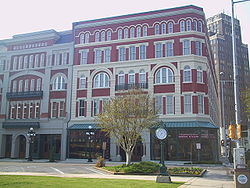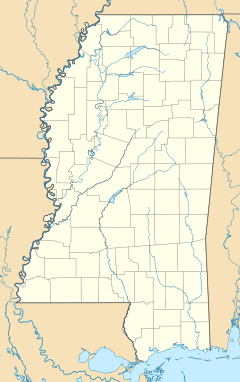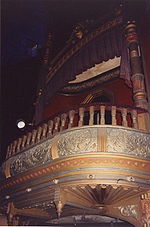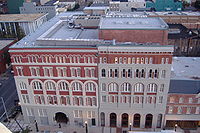- Riley Center
-
For the unincorporated community in Michigan, see Riley Township, St. Clair County, Michigan.Grand Opera HouseMississippi LandmarkThe Grand Opera House's location in Mississippi
Location: Meridian, Mississippi Coordinates: 32°21′50″N 88°42′0″W / 32.36389°N 88.7°WCoordinates: 32°21′50″N 88°42′0″W / 32.36389°N 88.7°W Built: 1890 Architect: Gustavus Maurice Torgerson; C.M. Rubush Architectural style: Late Victorian, Empire/Romanesque Visitation: ~63,000[2] (2007) Governing body: Private MPS: Meridian MRA (AD) NRHP Reference#: 72000696[1] USMS #: 075-MER-0086-NR-ML Significant dates Added to NRHP: December 27, 1972 Designated USMS: June 7, 1991[3] The Riley Center, also known as the Grand Opera House and formally as the Mississippi State University Riley Center for Education and Performing Arts is a performing arts and conference center in Meridian, Mississippi. Added to the National Register of Historic Places in 1972 and renovated in September 2006, it is remarkable for being preserved to its original beauty while incorporating the latest in modern technology and amenities. The Grand Opera House and the adjacent Marks-Rothenberg Department store were built in 1889 by two half brothers, Israel Marks and Levi Rothenberg.[4] In addition to the extensive theater renovation, the department store was completely transformed into a state of the art conference facility. Together the theater and conference space make up the Mississippi State University Riley Center for Education and Performing Arts, owned and operated by Mississippi State University-Meridian Campus.[1]
Contents
Original Opera House
Construction
In the late 19th century, Israel Marks and his half-brothers, Levi, Sam, and Marx Rothenberg, expanded their retail operations by opening a new wholesale and retail mercantile store and an adjoining hotel. The site chosen covered almost a half a block — five lots facing 5th Street and three lots consuming the entire length of 22nd Avenue between 5th and 6th Streets.[4] Construction began in 1889, under the direction of C.M. Rubush, a builder from Meridian. The exterior of the building was designed by Gustavus Maurice Torgerson, architect of Meridian's original City Hall. The original designs included a mansard roof, establishing the architectural style as late Victorian, Empire/Romanesque.[4]
For an unknown reason, construction of the hotel was interrupted in process, and the decision to go with a Grand Opera House was made instead. Factors that may have influenced the decision may have been:
- The top price for a ticket to a first-run production by a traveling company with a star, set at $1.50 (about the same price as a room in a decent hotel)
- The profit margin would be much larger for an opera house than a hotel
- Torgerson was familiar with the highly successful Grand Opera House of New Orleans, completed only a few years earlier.
- Mr. Marks spent most of the year in New York City. He would have been aware of the more successful shows, and, most probably, the booking and production houses of Klaw and Erlanger, the founders of the Syndicate—the most powerful commercial force in the American theater at the turn of the century.
Seeking quality work, the Marks-Rothenberg partnership hired J.B. McElfatrick of New York and St. Louis to design the interior of the Grand Opera House. McElfatrick had designed over 200 theaters in the United States, including the National Theater in Washington D.C. and the Metropolitan Opera House of Philadelphia, among others.
The stage, at 30 feet wide by 50 feet deep, could accommodate the largest, most lavish shows from New York. Under the 35-foot high arched proscenium was an ornate painted border which featured the famous "Lady." The "Lady" eventually became the symbol of the Opera House, and today the Grand Opera House is often referred to affectionately as "The Lady."[4]
Performances
The Opera House was completed in late 1890, in time for the December 17 opening of Johann Strauss's, "The Gypsy Baron," performed by a German language company from New York. The same company performed Adolph Mueller's "The King's Fool" the next night.[5][4]
Unlike the first two nights' presentations, most plays were simple melodramas that would have been very familiar to the city's residents. Sometimes, though, big names would perform; among them were Sarah Bernhardt in "La Tosca" and Henrik Ibsen in "Ghosts". The most popular form of entertainment at the opera house was that of the blackface minstrels, in which white performers with black paint on their faces impersonated African Americans in a humorous manner. Sometimes African American companies such as "Black Patti" were given the stage as well.[5]
Alterations and Renovations
The Opera House was remodeled in 1902, reopening on September 17. The change involved moving the original entrance left to the site of the former gallery entry. Three marble steps led up to the entrance, which had a metal extension gate that could be closed when the theater was dark.[4] Electricity capabilities were also added to the opera house in 1902.[5]
The Opera House was remodeled again in May 1920, when it was converted in part to a movie theater. The renovated theater opened on June 7, introducing the silver screen that can still be seen in the backstage area of the theater. This transition also divided the gallery into two areas, allowing a center opening for the film's projection.[4]
Fall of the Opera House
The demise of the Opera House began in 1923, when it was leased to Saenger Films of New Orleans under title of the Plaza Amusement Company at a cost of $1,000 a month for a period of 25 years.[4] The lease was for thirty years, but in 1927, Saenger bought the larger Temple Theater and wanted to gut the opera house into an office building. Because Levi Rothenberg, the previous owner (and builder) of the opera house had inserted a clause into the lease specifying that the building could only be used as a theater, the company abandoned the building and refused to pay rent.[5] After Saenger reneged on the lease, a long court battle ensued. The Rothenbergs eventually won the case, but the Great Depression had begun by then, Saenger had declared bankruptcy, Levi Rothenberg had died, and the Grand Opera House was closed.[4]
After the closing of the Opera House, the department store continued to operate under various ownerships until 1990.[6]
Restoration Efforts
Cause for Restoration
After being covered with metal siding in the 1960s as a part of a modernization trend, the building lost some of its historic character. In the 1980s, part of this siding was removed, and members of the community were reminded of how the building originally appeared, sparking attempts to restore the building. Over the next two decades, local efforts to "save the Grand Opera House" and restore the adjacent Marks-Rothenberg building garnered support.[6]
Funding
The first major donation to initiate fund raising came from The Riley Foundation in the form of a $10 million grant in 2000 with a stipulation that Mississippi State University own and operate the center[6]. The Riley Foundation donated another $2.1 million in 2005 for construction and technology upgrades. Other donations by local, state, and federal agencies followed, including a $4 million donation by Lauderdale County, a $3.6 million donation by the United States Department of Housing and Urban Development, and a $3 million donation from the United States Department of Commerce. The project's final price tag weighed in at slightly under $25 million.[7]
Riley Center Today
Now fully restored, The MSU Riley Center is designed to entertain and enrich, further lifelong learning, and improve the quality of life for people of Mississippi and West Alabama through education and the arts.[8]
Riley Center as seen from the Threefoot Building, another historic building in Downtown Meridian
The Riley Center includes a theater which seats approximately 950 people, a 200-seat studio theater, and 30,000 sq ft (2,787 m2) of meeting space, including a large exhibit hall, break out rooms, and board rooms, all equipped with teleconferencing capabilities and built-in technical features to create the optimal meeting environment.[9]
Specifications
The maple stage is raised 41 in (104 cm) above audience floor and is finished with dark brown stain. The stage's proscenium is 29 ft 4 in (8.94 m) wide and 19 ft 4 in (5.89 m) tall, with a depth 32 ft 6 in (9.91 m), and the apron extends 7 ft 2 in (2.18 m) into the crowd at center. The stage's left wing measures 8 ft 4 in (2.54 m), while the right measures 12 ft 6 in (3.81 m).[10]
Its two sets of black velour legs are 24 ft (7 m) x 12 ft (4 m). The stage includes one brick red teaser with gold trim measuring 34 ft (10 m) x 9 ft (3 m) with fullness, three slimmer black velour teasers measuring 40 ft (12 m) x 6 ft (2 m) with fullness, and two 24 ft (7 m) x 40 ft (12 m) black velour travelers, operated stage left. A 24 ft (7 m) x 40 ft (12 m) blackout is also present, along with a black scrim and a white bounce of the same measurement.[10]
Notes
- ^ "National Register Information System". National Register of Historic Places. National Park Service. 2007-01-23. http://nrhp.focus.nps.gov/natreg/docs/All_Data.html.
- ^ Meridian, MS 2007 Annual Report
- ^ "Mississippi Landmarks". Mississippi Department of Archives and History. May 2008. http://mdah.state.ms.us/hpres/MSLandmarks.pdf. Retrieved May 14, 2009.
- ^ a b c d e f g h i Grand Opera House Project
- ^ a b c d Dennis J. Mitchell. "Mississippi History Now – Grand Opera House of Mississippi". Mississippi Historical Society. http://mshistory.k12.ms.us/articles/167/grand-opera-house-of-mississippi. Retrieved 2010-05-22.
- ^ a b c MSU Riley Center - History and Renovation
- ^ MSU Riley Center - Funding
- ^ MSU Riley Center - Our Mission
- ^ MSU Riley Center - Overview
- ^ a b MSU Riley Center Tech Specs
External links
U.S. National Register of Historic Places Topics Lists by states Alabama • Alaska • Arizona • Arkansas • California • Colorado • Connecticut • Delaware • Florida • Georgia • Hawaii • Idaho • Illinois • Indiana • Iowa • Kansas • Kentucky • Louisiana • Maine • Maryland • Massachusetts • Michigan • Minnesota • Mississippi • Missouri • Montana • Nebraska • Nevada • New Hampshire • New Jersey • New Mexico • New York • North Carolina • North Dakota • Ohio • Oklahoma • Oregon • Pennsylvania • Rhode Island • South Carolina • South Dakota • Tennessee • Texas • Utah • Vermont • Virginia • Washington • West Virginia • Wisconsin • WyomingLists by territories Lists by associated states Other Categories:- National Register of Historic Places in Mississippi
- Buildings and structures in Meridian, Mississippi
- Visitor attractions in Lauderdale County, Mississippi
- Performing arts centers in Mississippi
Wikimedia Foundation. 2010.




